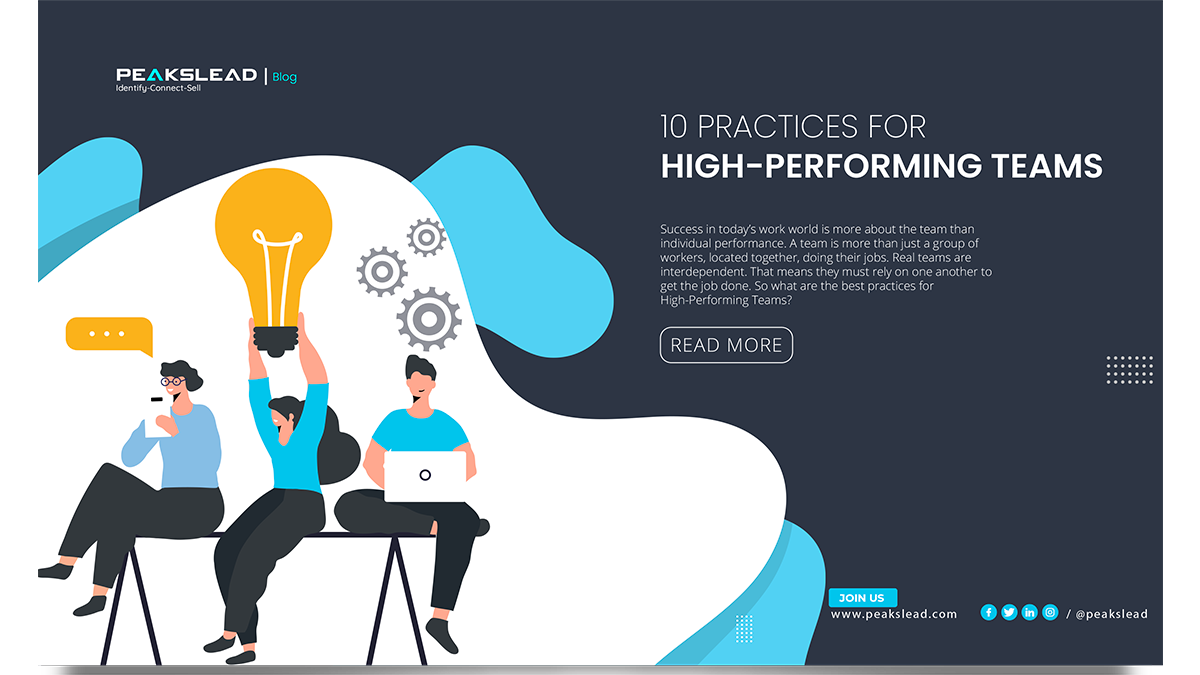To build a high-performance team, establish clear goals and foster open communication. Encourage collaboration and recognize individual contributions.
Building a high-performance team is crucial for achieving business success. This involves creating an environment where team members feel valued and motivated. Setting clear objectives helps everyone understand their roles and responsibilities. Open communication ensures that ideas and feedback flow freely, promoting a culture of transparency.
Encouraging collaboration allows team members to leverage each other’s strengths, leading to innovative solutions. Recognizing individual contributions boosts morale and keeps everyone engaged. Investing time in team-building activities can strengthen relationships and enhance trust. Providing opportunities for professional development ensures continuous growth. Regularly reviewing and adjusting strategies ensures the team remains aligned with organizational goals. Prioritizing these elements can significantly enhance team performance and drive success.
Clear Vision And Goals
Building a high-performance team starts with a clear vision and goals. This foundation ensures everyone moves in the same direction. Setting clear objectives and aligning team members are crucial steps.
Define Objectives
To begin, define the team’s objectives clearly. These objectives should be specific, measurable, achievable, relevant, and time-bound (SMART). Clear objectives help everyone understand their role and responsibilities.
Consider using a table to outline the objectives:
| Objective | Description | Deadline |
|---|---|---|
| Increase Sales | Boost sales by 20% | End of Q4 |
| Improve Customer Service | Reduce response time to under 5 minutes | End of Q3 |
Each team member should know these objectives. This ensures everyone is on the same page.
Align Team Members
Aligning team members with the vision and goals is crucial. Every member should understand how their work contributes to the bigger picture.
Use the following steps to align your team:
- Communicate the vision clearly and often.
- Discuss individual roles and their impact.
- Ensure everyone feels valued and important.
Team alignment reduces misunderstandings and fosters collaboration. This makes reaching goals more achievable.
Use these tips to create a high-performance team with a clear vision and goals.

Credit: www.linkedin.com
Effective Communication
Effective communication is the cornerstone of any high-performance team. It ensures that everyone is on the same page. Clear and open communication helps to avoid misunderstandings. It fosters a culture of transparency and trust. Let’s explore some key strategies to enhance communication within your team.
Open Channels
Open channels of communication are essential for a productive team. These channels allow team members to share ideas freely. Use tools like Slack or Microsoft Teams for instant messaging. Encourage face-to-face meetings for more complex discussions. Make sure everyone feels comfortable voicing their opinions.
Here are some tips for maintaining open communication channels:
- Use a dedicated space for team communications.
- Encourage regular feedback from all team members.
- Make communication tools easily accessible.
Regular Updates
Keeping everyone in the loop is crucial. Regular updates ensure that all team members are aware of progress. It helps in identifying issues early on. Use weekly meetings to provide updates on ongoing projects. Share progress reports through email or project management tools.
Consider these methods for regular updates:
- Weekly stand-up meetings.
- Daily email summaries.
- Project management software for real-time updates.
Regular updates help in maintaining alignment within the team. They ensure that everyone knows their responsibilities and deadlines.
| Method | Frequency | Purpose |
|---|---|---|
| Stand-up Meetings | Weekly | Quick updates |
| Email Summaries | Daily | Progress review |
| Project Management Tools | Real-Time | Task tracking |
Role Clarity
Role clarity is essential for building a high-performance team. It ensures each team member knows their responsibilities. This reduces confusion and increases productivity. Clear roles help avoid conflicts and improve collaboration.
Assign Responsibilities
Assigning responsibilities is the first step in achieving role clarity. Each team member should have a clear job description. This should outline their tasks and expectations. Here’s how to do it effectively:
- Conduct a job analysis to determine key tasks.
- Write detailed job descriptions for each role.
- Communicate these descriptions clearly to the team.
- Ensure that everyone understands their individual tasks.
Using a table can help organize these responsibilities:
| Role | Key Responsibilities |
|---|---|
| Project Manager | Oversee project execution, manage timelines |
| Developer | Write and test code |
| Designer | Create visual assets and user interfaces |
| QA Tester | Test functionality and report bugs |
Avoid Overlap
To maintain efficiency, it is crucial to avoid overlap in responsibilities. Overlapping tasks can lead to confusion and wasted effort. Here’s how to prevent this:
- Review job descriptions regularly to identify overlaps.
- Hold team meetings to discuss role boundaries.
- Use project management tools to track tasks and responsibilities.
- Encourage open communication for any role-related issues.
By following these steps, you can ensure that each team member’s role is distinct. This clarity leads to better performance and higher team morale.
Build Trust
Building trust is crucial for creating a high-performance team. Without trust, team members may feel insecure and disconnected. Trust fosters a sense of unity and collaboration. Here are some effective ways to build trust within your team.
Encourage Transparency
Transparency is the foundation of trust. Share important information openly with the team. This includes project goals, deadlines, and challenges. Encourage team members to voice their opinions and concerns. This creates an environment of honesty and openness.
Use regular meetings to update everyone on the project’s status. Involve the team in decision-making processes. This makes them feel valued and respected. Transparency reduces misunderstandings and builds a sense of community.
Foster Collaboration
Collaboration strengthens trust within the team. Encourage team members to work together on tasks. Create opportunities for them to share their skills and knowledge.
Use collaborative tools and platforms to facilitate teamwork. Tools like Slack, Trello, and Google Workspace can help. These platforms make it easy to share information and track progress. Team-building activities also promote collaboration. Organize workshops, hackathons, or social events to bring the team closer.
Recognize and celebrate collaborative efforts. Acknowledge team achievements and milestones. This boosts morale and reinforces a culture of trust and unity.
Empower Team Members
Empowering team members is crucial for building a high-performance team. When team members feel empowered, they take ownership and show initiative. This boosts overall productivity and morale. Let’s explore two key strategies to empower your team.
Delegate Authority
Delegating authority shows trust in your team. It allows members to make decisions. This builds their confidence and skills. Here are some ways to delegate effectively:
- Assign specific tasks to team members.
- Provide clear guidelines and expectations.
- Allow them to use their judgment in decision-making.
- Offer support, but avoid micromanaging.
When you delegate, your team feels valued. They understand their role and its importance. This encourages them to perform better.
Encourage Initiative
Encouraging initiative fosters a proactive mindset. Team members feel free to share ideas and take action. Here are some tips to encourage initiative:
- Recognize and reward new ideas.
- Create a safe environment for experimentation.
- Encourage open communication.
- Offer opportunities for professional growth.
When team members take initiative, they contribute more effectively. This leads to innovative solutions and improved performance.
| Strategy | Action | Benefit |
|---|---|---|
| Delegate Authority | Assign tasks, provide guidelines, and offer support. | Builds confidence, skills, and trust. |
| Encourage Initiative | Reward ideas, create a safe environment, and offer growth. | Fosters a proactive mindset and innovation. |
Continuous Learning
Continuous learning is the heartbeat of a high-performance team. Teams thrive with new knowledge and skills. It keeps them competitive and innovative. Let’s explore two key aspects: Training Programs and Skill Development.
Training Programs
Training programs are essential for team growth. They ensure members stay updated with industry trends.
- Workshops – Interactive sessions boost engagement and knowledge retention.
- Webinars – Online seminars offer flexibility and access to expert insights.
- Online Courses – Self-paced courses allow team members to learn at their own pace.
Investing in training programs fosters a culture of continuous improvement. It also equips the team with the tools they need to succeed.
Skill Development
Skill development focuses on enhancing individual capabilities. It is crucial for team effectiveness.
- Mentorship – Pairing team members with mentors accelerates learning and growth.
- Cross-Training – Encouraging employees to learn different roles increases versatility.
- Feedback – Regular feedback helps identify areas for improvement and growth.
Developing skills ensures each team member can contribute fully. It also builds confidence and job satisfaction.
| Method | Benefits |
|---|---|
| Workshops | Boosts engagement and retention |
| Webinars | Flexible and insightful |
| Online Courses | Self-paced learning |
| Mentorship | Accelerates growth |
| Cross-Training | Increases versatility |
| Feedback | Identifies improvement areas |
Embracing continuous learning transforms a good team into a great one. It ensures they are always at the top of their game.
Recognize And Reward
Building a high-performance team requires more than just skills and talent. Recognizing and rewarding your team members is crucial. It boosts morale and fosters a culture of excellence. Here are two effective ways to recognize and reward your team.
Celebrate Achievements
Celebrating achievements is a powerful way to recognize efforts. It keeps the team motivated and driven. Here are some ways to celebrate:
- Public Acknowledgment: Mention achievements in meetings or newsletters.
- Team Celebrations: Host a small party or team lunch.
- Award Ceremonies: Give out certificates or trophies.
| Achievement | Recognition Method |
|---|---|
| Project Completion | Team Lunch |
| Outstanding Performance | Award Ceremony |
| Innovative Idea | Public Acknowledgment |
Provide Incentives
Incentives motivate team members to perform better. They feel valued and appreciated. Here are some effective incentives:
- Monetary Bonuses: Offer cash rewards for exceptional work.
- Extra Paid Time Off: Give additional vacation days.
- Gift Cards: Provide gift cards to popular stores or restaurants.
Monetary bonuses can be especially motivating. They offer immediate gratification. Extra paid time off gives employees a chance to recharge. Gift cards are a simple yet effective way to show appreciation.

Credit: peakslead.com
Adaptability
Building a high-performance team requires adaptability. Teams must quickly adjust to new challenges. This adaptability ensures success in a dynamic environment. Let’s explore two key aspects: Embrace Change and Innovate Solutions.
Embrace Change
Change is constant. High-performance teams thrive by embracing it. They see change as an opportunity, not a threat. This mindset fosters growth and innovation.
Here are some ways to embrace change:
- Stay Open-Minded: Be willing to try new approaches.
- Communicate Effectively: Keep everyone informed about changes.
- Encourage Flexibility: Adapt roles and tasks as needed.
Innovate Solutions
Innovation is key to problem-solving. High-performance teams focus on creating innovative solutions. This keeps them ahead of competitors.
Consider these strategies for fostering innovation:
- Brainstorm Regularly: Hold sessions to generate new ideas.
- Leverage Technology: Use tools to streamline processes.
- Encourage Experimentation: Allow team members to test new methods.
Innovation and adaptability go hand-in-hand. Teams that innovate quickly adapt to changes.
Effective Conflict Resolution
Effective conflict resolution is essential for building a high-performance team. Conflicts can arise in any team setting. Handling them promptly ensures a harmonious and productive environment.
Address Issues Early
Addressing issues early prevents minor problems from escalating. Encourage team members to voice concerns as soon as they arise.
Use the following steps:
- Listen to all parties involved.
- Identify the root cause of the conflict.
- Discuss possible solutions.
- Agree on a resolution.
Early intervention saves time and promotes trust within the team.
Promote Mediation
Promoting mediation helps resolve disputes effectively. Mediation involves a neutral third party who facilitates the resolution process.
The benefits include:
- Neutral perspective on the conflict.
- Structured environment for discussion.
- Encouragement of open communication.
Consider mediation to foster a positive team culture and strengthen relationships.

Credit: www.zibtek.com
Strong Leadership
Creating a high-performance team requires strong leadership. Effective leaders inspire and guide their teams to success. They foster trust, encourage collaboration, and set clear goals. Two key aspects of strong leadership are leading by example and providing guidance.
Lead By Example
Leaders must set the standard for their teams. They need to demonstrate the behaviors they want to see in their team members. This means showing dedication, being punctual, and maintaining a positive attitude. When leaders exhibit these traits, team members are more likely to follow suit.
For example, if a leader is always on time for meetings, the team will likely adopt the same habit. Also, leaders should show their commitment to quality work. If they pay attention to detail, their team will too.
Provide Guidance
Effective leaders offer clear guidance to their teams. They set clear goals and provide the necessary resources to achieve them. This helps team members understand their roles and responsibilities.
Guidance also involves regular feedback. Leaders should provide constructive criticism and praise to help team members grow. This boosts confidence and improves performance.
Additionally, leaders should be accessible. Team members should feel comfortable seeking advice or clarification. Open communication lines build trust and enhance team cohesion.
Frequently Asked Questions
How Can I Improve Team Communication?
Effective communication is key to a high-performance team. Encourage open dialogue, active listening, and regular feedback sessions. Use collaborative tools and set clear expectations.
What Are The Benefits Of Setting Clear Goals?
Clear goals align team efforts and provide direction. They help measure progress, improve focus, and boost motivation. Goals should be specific, measurable, and achievable.
How Do I Foster Trust Within My Team?
Trust is built through transparency, reliability, and integrity. Encourage team bonding activities, recognize achievements, and maintain open communication. Address issues promptly and fairly.
Why Is Diversity Important For Team Performance?
Diversity brings different perspectives and ideas, enhancing creativity and problem-solving. It fosters innovation and can lead to better decision-making. A diverse team is more adaptable.
Conclusion
Building a high-performance team is essential for success. Implementing these 10 strategies fosters collaboration and boosts productivity. Focus on clear communication, trust, and continuous development. Your team will thrive, achieving outstanding results. Start implementing these tips today and witness transformative growth in your organization.
The journey to excellence begins now.
